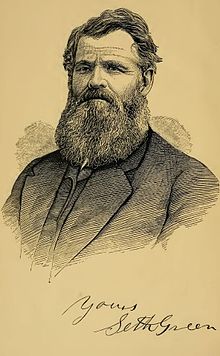Seth Green (pisciculture)
| Seth Green | |
|---|---|

Seth Green from his work Trout Culture (1870)
|
|
| Born | March 19, 1817 |
| Died | August 18, 1888 (aged 71) |
| Resting place | Mount Hope Cemetery, Rochester, New York |
| Nationality | American |
| Known for | Fish Farming pioneer |
Seth Green (March 19, 1817 – August 18, 1888) was an American pioneer in fish farming (pisciculture and aquaculture). He established the first fish hatchery in the United States in the Town of Caledonia, New York. He was a successful commercial fisherman, operating a large and profitable fish and game market in Rochester, New York. After many years of operating his commercial hatchery in Caledonia, he entered government service with the New York State Fish Commission and eventually became Superintendent of Fisheries for the state of New York. Seth Green's pioneering efforts to raise fish stocks and restore fish populations for sporting purposes established a standard of aquaculture recognized internationally. He is commonly referred to as the "Father of fish culture in North America."
Seth Green was born in Rochester, New York, the son of farmer Adonijah Green and wife, Betsy Bronson. He had one brother and two sisters. He grew up as an outdoor enthusiast in the small village of Carthage along the Genesee River near Rochester learning fishing skills from his father and the local Seneca. His formal schooling was limited to finishing fifth or sixth grade at a local Carthage district school. When the financial Panic of 1837 severely impacted the economy of Carthage, he left home and decided to take up commercial fishing along the Genesee River. In 1848 he married a local Rochester girl Helen Cooke. They established a fish and game market in downtown Rochester which he operated with his brother and partner, Monroe Green. By 1857 the market employed more than 100 people. It was one of the largest and most prosperous fish markets in the region. To supply his market Green traveled the shores of Lake Ontario over the years for fish. He and his fishermen survived many storms and hardships on Lake Ontario to supply the market with from 0.5 to 3 short tons (450 to 2,720 kg) daily. Early in his commercial fishing business, he observed Atlantic salmon spawning near Cobourg, Ontario and conceived the idea of propagating his own stocks of fish, not only for market but to restock streams for sport fishing.
...
Wikipedia
